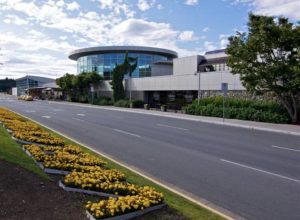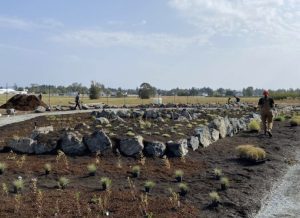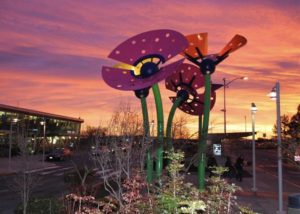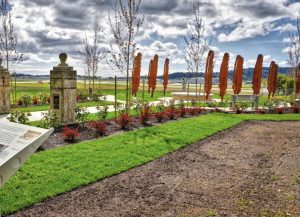In today’s rapidly changing world, environmental consciousness is at the forefront of many industries, including commercial landscaping. Property owners and landscaping professionals are recognizing the need for sustainable practices that enhance the beauty of commercial spaces and contribute to a greener, more eco-conscious future.
This blog explores the exciting eco-revolution happening in the world of commercial landscaping. We will delve into innovative practices, share inspiring examples, and highlight the numerous benefits of adopting eco-friendly landscaping techniques. Whether you’re a property owner looking to enhance your commercial space or a landscaping professional seeking new approaches, this guide has something valuable to offer.
Sustainable Landscaping in Action
Let’s kick off our journey into commercial landscaping’s eco-revolution with some concrete examples of sustainable landscaping practices that are making a significant impact:

1. Native Plant Landscaping
One of the fundamental shifts in commercial landscaping is the move towards using native plants in design. Native plants are naturally adapted to local environmental conditions, reducing the need for excessive watering and chemical maintenance. By incorporating native species into your landscaping plans, you conserve water and support local biodiversity.
Example: Imagine a Victoria campus transformed with colourful arrays of drought-resistant native wildflowers and grasses, attracting local wildlife and reducing the need for constant irrigation.
2. Smart Irrigation Systems
Traditional sprinkler systems are notorious water wasters. The eco-revolution is ushering in smart irrigation systems that use advanced technology to monitor weather conditions, soil moisture levels, and plant needs. These systems optimize watering schedules, reducing water wastage and ensuring healthier landscapes.
Example: Our Customer, the Victoria Airport, implements a smart irrigation system that adjusts watering times based on real-time weather data, leading to a 30% reduction in water consumption and lush, thriving greenery.

3. Sustainable Hardscaping
Eco-conscious landscaping continues beyond plants. It extends to hardscaping elements like walkways, patios, and retaining walls. Sustainable materials like permeable pavers and recycled stone are gaining popularity. They allow rainwater to permeate the ground, reducing runoff and preventing erosion.
Example: A Victoria hotel revamps its outdoor dining area with permeable pavers, improving drainage and creating an elegant, eco-friendly ambiance for guests.

4. Green Roof Innovations
Commercial buildings increasingly adopt green roofs, which cover rooftops with vegetation. Green roofs offer insulation, reduce energy costs, and mitigate the urban heat island effect. They also provide a habitat for birds and insects.
Example: An office complex in the heart of the city installs a lush green roof garden, reducing its energy consumption by 15% and providing a tranquil space for employees to unwind during breaks.
5. Xeriscaping for Water Efficiency
In regions with water scarcity, xeriscaping is gaining prominence. This landscaping technique focuses on using drought-tolerant plants, mulch, and efficient irrigation to create visually appealing landscapes while drastically reducing water consumption.
Example: A retail center in a dry climate adopts xeriscaping, reducing its water usage by 50% and becoming a local symbol of water-conscious landscaping.

6. Pollinator Gardens
As awareness of pollinator decline grows, more commercial spaces incorporate pollinator gardens into their landscapes. These gardens attract bees, butterflies, and other essential pollinators, helping to support local ecosystems and agriculture.
Example: Victoria Airport creates a vibrant pollinator garden that beautifies the grounds and contributes to the nearby garden’s health through increased pollination.
7. Sustainable Maintenance Practices
The eco-revolution isn’t limited to design; it also extends to maintenance. Sustainable practices like organic pest control, composting, and reduced mowing frequency are becoming standard in commercial landscaping.
Example: A golf course switches to organic fertilizers and pest control methods, resulting in healthier turf and significantly reduced chemical usage.

8. LEED Certification for Landscapes
Leadership in Energy and Environmental Design (LEED) certification is not limited to buildings. Commercial landscapes can also achieve LEED certification by meeting specific sustainability criteria. This certification demonstrates a commitment to environmental responsibility and can enhance a property’s value.
Example: An apartment complex achieves LEED Platinum certification for its sustainable landscaping efforts, attracting environmentally-conscious tenants and investors.
Benefits of Going Green
The examples provided here showcase the diverse ways commercial landscaping embraces eco-friendly practices. But what are the benefits of this eco-revolution for property owners and landscaping professionals?
- Cost Savings: Sustainable landscaping often reduces water and maintenance costs, leading to long-term savings for property owners.
- Enhanced Aesthetics: Eco-friendly landscapes can be just as, if not more, beautiful than traditional ones, attracting visitors and customers.
- Environmental Stewardship: Participating in the eco-revolution demonstrates a commitment to environmental sustainability, which can improve a company’s image.
- Regulatory Compliance: In many areas, sustainable landscaping practices are becoming mandatory to comply with local environmental regulations.
- Property Value: A well-designed and sustainable landscape can increase property value, making it a wise investment for property owners.
In the next part of this blog, we will dive deeper into how landscaping professionals can implement these practices and provide additional insights for commercial property owners looking to embark on their own eco-friendly landscaping journey.